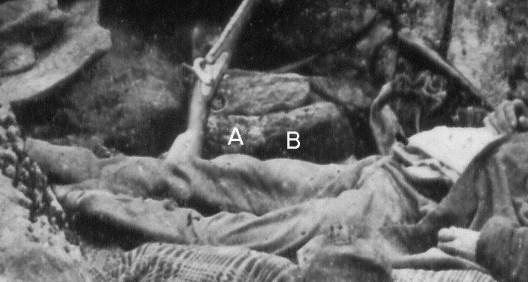
Further Details
Close-ups of the various photographs reveal hidden insights:
Previously, I have shown a close up of the rock on the pant leg as seen in the first shot of the sharpshooter. For perfect comparison, here is a closeup shot of the potato-shaped rock as seen in the stereo image (the second photo made of the sharpshooter):

As in photograph (1), the hefty rock -- perhaps weighing every bit of 10-15 pounds-- is clearly resting on the lower section of the sharpshooter's shin-side in this closeup of photograph (2).
There is something else that should be remarked upon. Easily seen in both photos 1 and 2 are wrinkles in the right trouser leg: Note the letters A & B
just above the pant leg. These are latitudinal (concentric) wrinkles in the pants that are very normal in
appearance; that is, they form around the trouser leg. To the right of the rock other latitudinal wrinkles can also be seen.
I wish to emphasize, these wrinkles correspond in every way to the usual folds and wrinkles that occur in worn clothing. In this case, all wrinkles are likely somewhat "set" by the damp encountered through the rainy weather after the battle.
Now take a gander at this downhill shot (photograph 4) showing a close-up of the same area as above, but now minus the potato-shaped rock:
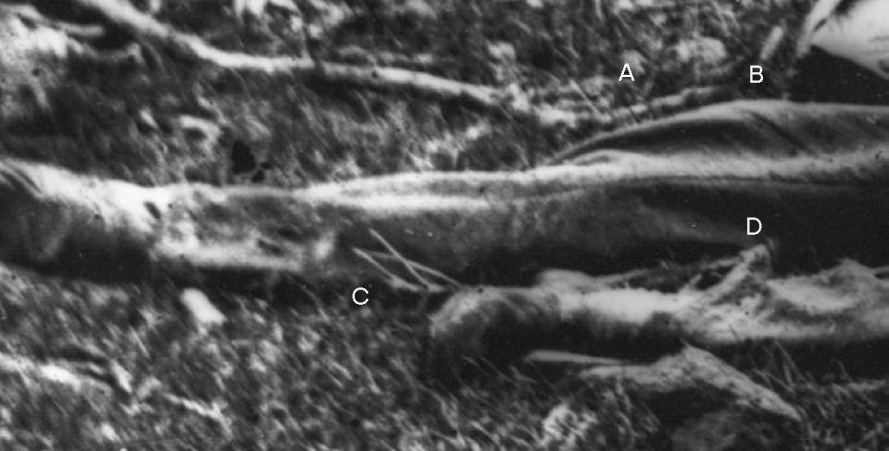
The perfectly matching crater is unmistakable. But now, additionally, look at the entire right pant-leg and note all latitudinal wrinkles visible uphill have now been smoothed out. Very interestingly, note how the two once latitudinal wrinkles at A & B are now forced into a single LONGITUDINAL (transverse) wrinkle, that is, a wrinkle parallel to the direction of the leg. I wish to point out that only one means can be found for forming this long and up-standing longitudinal formation. The pant leg had to have been TUGGED on and recently so, for the many heavy rains occurring since time of death (Friday-early Saturday, Saturday afternoon and night, Sunday off-and-on, etc.) would have surely flattened such a long and billowing wrinkle ; that is, were this body originally found at this downhill location, having supposedly laid there since Thursday evening.
It is a curious condition, this transverse wrinkle. I cannot conceive of the photographers actually pulling on the sharpshooter's pant leg if they have just come upon him at this downhill location. BUT, if they dragged the
body from its uphill "home" without first removing that 10-15 pound rock, such a weight would
have perfectly contributed the necessary tugging force (just before rolling off in transit) required. And, add to that pulling force the friction of the ground passing underneath the body/leg as it was dragged downhill. The billowing transverse fold atop the leg would be the perfect result of such action.
BTW, note the little object stretching from C to D above. Here is an even closer view:
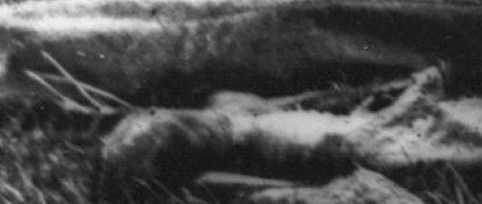
What you are seeing is a dead twiggy branch caught in the sharpshooter's left trouser leg. I wish
to point out that rigor has not yet entirely left the body (normally, rigor leaves the body last at the
legs). This lingering rigor condition is indicated by the stiff and non-shifting position of the
legs, even though the body was dragged downhill for quite a ways. Regarding the branch, note
how the three radiating twig tines (to the left above the shoe-toe) all emanate from the same side of the branch.
This VERY strongly indicates this branch is a dead Coniferous tree bough.
Very curious how it's been snagged. A man walking upright could rarely have picked up such
bough-- tines downwards. However, a body being dragged through coniferous tree debris
could easily have taken on such a woody "hitch-hiker" and in exactly this "flag trailing"
condition.
For comparison viewing, I will herein supply a common Spruce bough:
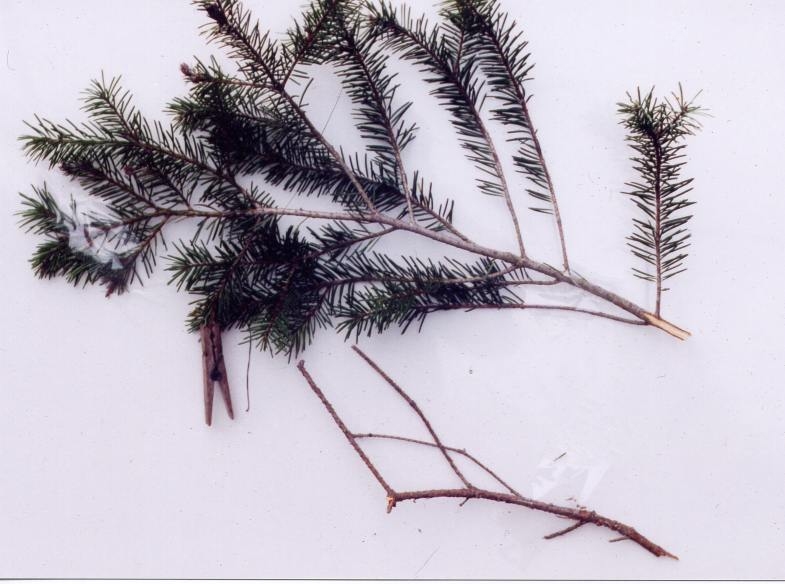
Again, Coniferous tree boughs have tines that quite regularly radiate straight out from only two opposite
sides of the main stem. Thus, in normal appearance they differ greatly from Deciduous trees. I indicate with the
common clothespin the relative size of the Spruce bough and I also show a dead bough version found
on the ground beneath the living spruce (though it is not as long as the dead bough shown in the
sharpshooter close-up). I chose this particular dead bough because it had one of it's tines bent
forward in the same manner as the Sharpshooter's "hitch-hiker". You will likely note I took the
liberty of artificially bending one of the green bough's tines forward in like manner for the
snap-shot. My point being that though all the tines, by their nature, normally radiate outwards
from either side of the main stem, they can seem to cross over one another on occasion.
The likely coniferous hitch-hiker is very curious! What I means is, I see other twigs and branches
in the photographs but they are the typical Deciduous varieties. Thus, this Coniferous bough is
unique. What an amazing coincidence to find it attached (hooked) to the dead body.
Considering that the body was dragged downhill, the question is this: are there any Coniferous
trees visible in the area between the uphill wall and boulders position and the downhill final
resting spot? Realize, the spread of six photos gives ample visual coverage of the entire area
under consideration for movement of the body. Take a look at photo 5 which clearly shows the
entire path of the bodies movement:
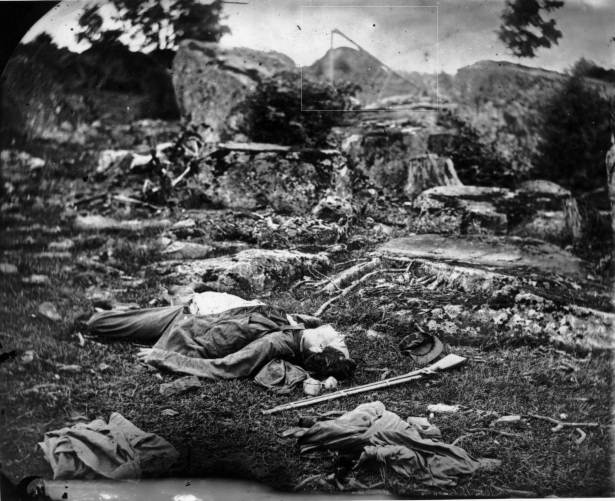 Indeed there is. The dead and visibly broken Coniferous tree already noted in a much earlier discussion. I wish to point out, except for the apparently blasted but still-alive
little Cedar (also uphill), this dead Coniferous tree is the only other one visible in all six
photographs.... and, also like the blasted Cedar, it is situated this Western side of the uphill wall
and boulder's position; and directly in the path required to drag the body to the downhill
position.
Indeed there is. The dead and visibly broken Coniferous tree already noted in a much earlier discussion. I wish to point out, except for the apparently blasted but still-alive
little Cedar (also uphill), this dead Coniferous tree is the only other one visible in all six
photographs.... and, also like the blasted Cedar, it is situated this Western side of the uphill wall
and boulder's position; and directly in the path required to drag the body to the downhill
position.
The visual realm is a place wherein all can see and judge for themselves. The photographers have betrayed themselves in these and numerous other ways; indeed, they left so many visual clues: good shoes, likely Union issue ; a haversack full uphill, then empty downhill ; so many items of value at the "Home" left untouched; the likely sawing of an intervening aspen tree to allow un-obstructed view and light upon the body ; ....and items typical to sharpshooters, like a riflecase and a plausible piece of the long range rifles' scope....
For those who would like the opportunity to see that potato-shaped rock in 3-D, I keep that stereo safely at my gallery. All are welcome to visit. [ultimately, I had to purchase this stereo twice from the LOC ; the first copy was lost when I lent it out. That was troublesome but the loss did produce a happy ending. I did not have the stereo's copy number; and the LOC re-pro staff could not at first find the copy negative. Though it took a couple of months to finally get it, this second copy surpassed my expectations. I have to suspect it was either created from an especially good copy negative; or it may have come directly from the actual and original glass plate negative. Whatever it's means to creation, the LOC re-pro staff really produced a better and sharper article. My hat is off to them for 'going the extra mile'.]
End piece of a rifle scope?
I have heard it mentioned the piece of tubular metal I and others see within the uphill photographs is no such thing; but instead, a bayonet scabbard. I wish it known I have painted a good many bayonet scabbards in my life and anyone wishing to view such military accouterments may easily find them in several well-illustrated books on ACW equipment. I believe most bayonet scabbards were made by stitching three tapered leather sections together, forming a long triangular-ish tube. Then again, I do recall seeing another version where there was only one seam. Still, though a bayonet scabbard may appear to some eyes to match that item lying in the "Home" site, this artist just cannot see it. What I see in the old photos is very thin yet does not succumb or slump to wet weather. What I mean is, I see a non-tapered and straight cylindrical form more matching that of sheet metal. I looked at this item for many months before deciding it most likely favored the rear section of a typical-to-the-time riflescope. I still cannot fathom it as being a scabbard, nor can I even imagine what could happen to a scabbard to make it take on this weird configuration.
I have received several letters from folks who actually own NTR's.
To my appreciative delight, one contact even sent along some very fine photos of his 1850's prize. I thank Mr.
Mark Peterson of Pennsylvania for the following snap-shot showing the rear section of his own
target rifle.
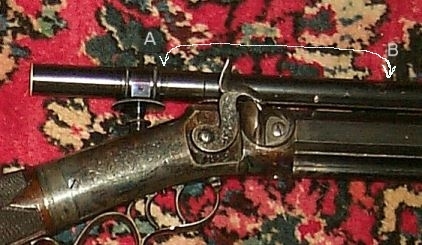
Note that the scope-- like the one at the park museum-- has a seam cover and that this cover ends where the scope becomes encircled by a winding of sheet metal soldered around the scope tube. This re-enforced end then enters the
rear mounting collar; the eyepiece section (seen at far left) is finally screwed into the mounting collar.
For the sake of comparison, I will again show the object lying visible in the two uphill "Home"
photos with my lines of demarcation:
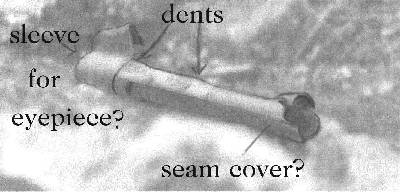
I might understand how some seeing this blurry item might see a taper but my own eyes are not fooled by the dents, which allow a slight widening appearance where they occur. And again, I cannot fathom how the damage at the near end could have formed with a leather scabbard ; yet it could so easily form with tubular sheet-metal.
As always, I am left with the notion that this item best matches the visual configuration of a section of riflescope ; more precisely, the rear section ; and that something forcefully passed through this section of the scope and likely split open the entire seam along it's (unseen) underside. Do recall the NTR at the park does appear to be missing this rear section in it's own museum piece. Also recall this rifle was found in the DD on Sunday, July 5th, by young Rosensteel. ; his search likely performed after the Union 5th Corps left the field in early afternoon. Reviewing the photos supplied in this report, note that this particular NTR's rear telescope-mounting collar is half torn away, i.e., missing its upper ring section (the scope now held in place by "fishing line"); also, that its "eyepiece" is a dud plopped on the trued-up end, and is, as such, not its original -- an original eyepiece which most likely would have matched the eyepiece shown above on Mr. Peterson's rifle, as at the time, and due to scarce manufacturers, were mostly made by the same few outfits.
BTW, Rosensteel is a primary historical source. He said the NTR was found in the DD on Sunday, the 5th of July, ‘63. We cannot simply disagree with primary historical sources without other conflicting PHS accounts or something equally as strong, such as photographic evidence to the contrary. In this case, there is none such. According to the visual clues of the valuable equipment left at the "Home", the sharpshooter was likely alone when he died in the DD. That makes his rifle plausibly lying somewhere near his body, along with all the other valuable items. Capt. Martin says a cannon shell caused the SS's demise. The rifle is damaged in manner consistent with nearby blast force. The rife had a scope. The scope and its rear mount as well as the rifle's lock are seen today to be obviously damaged. The famous "Home" photo does seem to show the rear section of a rifle's telescope. And, as stated previously, the Union forces would conceivably leave the damaged NTR laying on the battlefield.
Why would the Union Troops scouring the area not pick up this sharpshooter's rifle? Again, the Union 5th Corps left the battlefield Sunday afternoon. That certainly gave the Union plenty of time between Saturday and Sunday afternoon to retrieve valuable equipment from the entire area. I have no doubts the Union troops entering the valley of death around 10 AM Saturday morning did find a few valuable and usable weapons in that area and, somewhat later on, in the DD/Houck's ridge area. But NOT MUCH on the Western (hidden from LRT view) side of the hill as the equipment-needy Confederates had doubtless gleaned most everything deemed valuable during their occupation of the DD and Houck's Ridge on Thursday evening ( under cover of darkness, they even took Union Captain James Smith's captured forward cannon elements ). Doubtless, the scouring Union troops COULD have found some weaponry amongst the bodies found in the Slaughter Pen area of the upper Plum Run gorge, as that location was under direct vision and deadly federal fire from the summit of LRT. In agreement with such reasoning, the many photographs later made in the area show no such weapons or valuables lying about (just the prop rifle carried by the photographers and used again and again).
However, in the DD sharpshooter's case, he was most likely doing duty on Friday. Evidence shows he died alone. Thus, there were no Confederates in the area to retreive his weapon. It would have been there when the Union troops came into the area. If it were damaged and had parts-missing, the Union would have had no need for it. How can I say this? Easily enough. You see, when the war began, the Federal Government commissioned many available northern gunsmith to turn out NTR's as quickly as possible. By 1863, there would have been plenty of complete NTR's available to union sharpshooters. But use for such was in decline. In fact, the Gettysburg conflict marked the first major use of the new Sharps Breechloading SS rifles. The NTR's days were numbered. With this in mind, I see no good reason to doubt a damaged and cumbersome sharpshooter's target rifle was simply left upon the field by the Union troops scouring the DD/Houck's Ridge area.
Augustus Martin; could he have made-up his account after seeing Gardner's photograph?
Captain Martin was also a Primary Historical Source to certain events occurring in the Little Round Top/Devil's Den area during and after the famous battle. I understand there are many today who hold Martin's account in suspicion -- this because his account perfectly bolsters the dead sharpshooter as historical fact. Primary historical sources are rare finds and, lacking any contrary reports from other primary historical sources, will always be held in high regard by those guardians of battlefield fact/truth.
My own attempts to find error with Martin's account yielded nothing. On the contrary, everything in the photographs and on site today does seem to support his account, right down to the very odd and existing triangular dent on the face of the granite boulder and the condition of the body (the sharpshooter lying on his back, shirt pulled out and unbuttoned, trousers opened to the crotch, indicating Martin and friend's attempts to find a wound on the body. A bit further along, I will again supply Martin's account. It was given at the very beginning of the DDSS Report).
Kurt Graham of Georgia, who has been with me almost from the start in this undertaking, is an excellent sleuth for obtaining historical fact. Mr. Graham conducted research into Martin's subsequent life beyond the battlefield. After some digging, Kurt informed me Capt. Martin returned to his home in Massachusetts and eventually went into political office, serving as Boston's Water Commissioner, then Boston's Police Commissioner, then, finally, as Mayor of that large city. And so the Captain eventually became Mayor of Boston. To say the least, this sounds like a man who was well respected in his day.
Why is this man's account under suspicion today? I understand it is this: Captain Martin re-visited the battlefield in 1899 and it was at such time that his story about the sharpshooter was picked up by a local reporter from the Gettysburg Compiler. The suspected contention? One of the photographers, Gardner, published a photography-illustrated book, "A Photographic Sketchbook of the Civil War", in 1866. Of course, included therein was the not-yet-famous "Home of a Rebel Sharpshooter" photograph. Those today wishing to cast doubt on Martin maintain the artillery captain doubtless saw the "Home" photo sometime prior to his 1899 visit to the battlefield. They say the photo was famous though I understand few of Gardner's books were made or sold during the 19th Century (further, I am not aware of any historical evidence that says this particular photograph became famous until the later part of the 20th Century). Anyway, whether it was famous or not, the gist is, that after seeing this photograph, the artillerist, Captain Martin, who all agree was on LRT during the battle, was inspired to completely make up a nice story surrounding it and casting himself and his brethren within it.
I would like to say there is no evidence to support this contention. I can see where a story might be concocted during the many years after battle; still, Martin's story not only appears credible, it does match all visual and historic evidence. Obviously, in his time, Captain Martin went on to lead an honorable life. There is nothing negative about the man with which to base such slandering opinion.
Attention to facts and logic
This question as to whether or not Captain Martin made up his story after seeing the ‘famous photograph' can be easily solved by a simple knowledge of the battlefield coupled with a careful reading of both Martin's and the photographer's textual accounts. For this judgement, all that is required is some careful attention to the written word.
I will here supply the entire whole of Gardner's text which accompanied his "Home" photo. Please read it over carefully several times so that we can then all agree it is ultimately obvious Captain Martin had to be where he said he was and that he truly did see what he said he saw.
The Home of a Rebel Sharpshooter.
By Alexander Gardner
Text for Plate 41 in Gardner's Photographic Sketch Book of the War, published,
1865-66.
"On the Fourth of July, 1863, Lee's shattered army withdrew from Gettysburg, and started
on its retreat from Pennsylvania to the Potomac. From Culp's Hill, on our right, to the
forests that stretched away from Round Top, on the left, the fields were thickly strewn
with Confederate dead and wounded, dismounted guns, wrecked caissons, and the debris
of a broken army. The artist, in passing over the scene of the previous days' engagements,
found in a lonely place the covert of a rebel sharpshooter, and photographed the scene
presented here. The Confederate soldier had built up between two huge rocks, a stone wall, from the crevices of which he had directed his shots, and, in comparative security, picked off our officers. The side of the rock on the left shows, by the little white spots, how our sharpshooters and infantry had endeavored to dislodge him. The trees in the
vicinity were splintered, and their branches cut off, while the front of the wall looked as if just recovering from an attack of geological small-pox. The sharpshooter had evidently been wounded in the head by a fragment of shell which had exploded over him, and had laid down upon his blanket to await death. There was no means of judging how long he had lived after receiving his wound, but the disordered clothing shows that his sufferings must have been intense. Was he delirious with agony, or did death come slowly to his relief, while memories of home grew dearer as the field of carnage faded before him? What visions, of loved ones far away, may have hovered above his stony pillow! What familiar voices may he not have heard, like whispers beneath the roar of battle, as his eyes grew heavy in their long, last sleep!
On the nineteenth of November, the artist attended the consecration of the Gettysburg Cemetery, and again visited the
"Sharpshooter's Home." The musket, rusted by many storms, still leaned against the rock, and the skeleton of the soldier lay undisturbed within the mouldering uniform, as did the cold form of the dead four months before. None of those who went up and down the fields to bury the fallen, had found him. "Missing," was all that could have been known of him at home, and some mother may yet be patiently watching for the return of her boy, whose bones lie bleaching, unrecognized and alone, between the rocks at Gettysburg."
So ends Gardner's account. He describes a vista stretching from Culp's Hill on his right to Round Top on his left. He gives no clue as to how close he is to Culp's Hill nor to (big) Round Top. It would seem he is facing South-East-- perhaps, since he aludes to it, looking towards Lee's departing wake ; but we cannot say for certain where he was when he made this observation. I might carefully presume he is referring to that wide vista seen near the town from somewhere along or near the Emmitsburg Road. But who knows?
Anyway, apart from Gardner's describing this stretching vista and a few other mentions like the sharpshooter's disordered clothing, some/most of the accompanying narrative seems to be of complete contrivance; and, by-the-way, all the experts who are today familiar with this narrative agree with this assessment; and so the text supplied by Gardner appears mostly conjured. For example, as concerning the dead sharpshooter, Gardner falsely describes his "Home" photograph location as being in a "lonely place" on the battlefield.
I now invite you to again review the story told by Captain Martin. Please read it carefully.
"Eyewitness account of Captain Augustus P. Martin, commander of the Union V Corps artillery at Gettysburg (From "Gettysburg Compiler", October24, 1899)
"Among the interesting incidents that occurred on Little Round Top was the summary way in which a sharpshooter was disposed of in rear of Devil's Den. He had concealed himself behind a stone wall between two boulders and for a long time we were annoyed by shots from that direction, one of which actually combed my hair over my left ear and passed through the shoulder of a man a little taller than myself who was standing behind me for a cover. At last we were able to locate the spot, by the use of a field glass, from whence the shots came by little puffs of smoke that preceded the whizzing of the bullets that passed by our heads. We then loaded one of our guns with a percussion shell, taking careful and accurate aim. When the shot was fired the shell struck and exploded on the face of one of the boulders. We supposed the shot had frightened him away, as we were no longer troubled with shots from that location. When the battle was ended we rode over to the Devil's Den and found behind the wall a dead Confederate soldier lying upon his back and, so far as we could see, did not have a mark upon his body, and from that fact became convinced that he was killed by the concussion of the shell when it exploded on the face of the boulder."
You see? There is no way Martin's story could have in any way originated from his seeing Gardner's photograph and book --even if he had chanced to see the man or his photo. Rather and again, his story seems to bear out totally with time and fact, then and now.
Perhaps you didn't see it. That's OK; you have lots of good company. It's quite normal to miss it. Folks who regularly traverse the very battlefield have missed it, too.
What am I talking about?
Location, location, location.... on the geographic landscape of one huge and very extensive (miles long) battlefield. In this situation, where one man (Martin) is presumed to "steal" and build upon another man's idea (Gardner's book and photograph), the reality of the landscape means everything to the matter.
If I might focus on Captain Martin's landscape, he says in his story the sharpshooter was located "in rear of Devil's Den". Though Martin's words are few, he says a lot.
What does photographer Gardner say about the landscape? Gardner's story maintains only that the dead sharpshooter was located in a "lonely place" on the battlefield, contending it to be so remote that no one ever found the sharpshooter or his rusty rifle. As for possible clues to the photograph's location within the actual physical landscape, in his "Sketchbook" the photographer only mentions coming upon the body somewhere within the vastness of that area between Round Top on his left to Culps Hill on his right ....which is a VERY, very large panoramic area.
Thus, Gardner's account does not give the actual physical location of the ‘famous' photo. And so here is where the geographical topography of the battlefield comes into the matter. Let me tell you something interesting about the G'burg Battlefield. Much of the battlefield from Culps Hill to Round Top-- and well beyond, even extending into the town of G'burg itself and northwards -- is FULL of granite boulders. We are speaking of literally square miles of such boulders. Considering this vast coverage of granite boulders, the simple question then becomes this: if Martin fabricated his story from and after seeing Gardner's photograph, how did he know the body behind the wall and boulders was situated in "rear of Devil's Den"? Do realize, this is precisely where the sharpshooter was located when one considers Martin was an artillerist situated on LRT. Realize (please read it again) there is NO mention of Devil's Den ( or LRT, or Houcks Ridge) anywhere in the Gardner's 1866 "Sketchbook" narrative. Nor is there a mention in the same book's previous photo (plate 41) titled "A Sharpshooter's Last Sleep" (which is one of the four views of the dead sharpshooter made at the downhill site).
All things considered— and I mean that — this simple observation denies any thoughts that the Captain could have simply made up his account after seeing Gardner's "Home" photograph. And, aside from all the other things found in his account— things agreeing to the visual evidence throughout the 6 photographs — do remember the Captain's mention of the percussion shell hitting the face of one of the boulders, and that a plausible "dent" does still yet appear nearly smack-dab center on such Eastern face.
There you have it. Gardner never gave the location of the photograph. Logic dictates the Captain could not have invented his story from simply seeing Gardner's photograph. No man could, that is, and have such invention bear scrutiny, as Martin's account does so very well. When all is considered, Martin's account, though finding its way quite late into a Gettysburg news source, appears authentic in every proper way.
[Yes, it occurred rather late. 1899.... that's 36 years after the battle.... and that's a long time for a man to keep such an interesting story to himself. I have a hunch Martin may have told this particular sharpshooter account on many occasions; for instance, to family and friends. And, being a public figure, Martin may have told it to some others, too. What I mean is, this sharpshooter story may have found its way into a newspaper much sooner than 1899; and far from the battlefield where the original event took place.
If there is a historian in the Massachusetts environs who might do duty and search through the old newspapers and chronicles, I would appreciate hearing from you. Who knows what you might dig up? After all, this man, who was a Union Artillery Captain, then twice Boston Commissioner, then Boston Mayor, was a well-known figurehead in his day. I think it likely Martin would mention his sharpshooter experience to some other reporter, not just the late-in-life report carried into the G'burg Compiler upon his later-day visit to the battlefield.]
Updates 2002. The search for HCP
Kurt Graham has found a plausible candidate for the forgotten sharpshooter. I agree this particular soldier seems quite suiting to the circumstances.
No, he is not HCP. Rather instead, his name was William Adair, a member of the 3rd Georgia Battalion of Sharpshooters under Wofford. William Adair was 33 or 34 at the time of the battle. After the battle, Adair was listed as KIA on the 4th of July.
Mentioned in the DDSS Report was one J. A. Carter, a member of the 3rd Georgia and listed as MIA on the 3rd. Kurt eventually found James Carter was captured by Union troops and survived the war. There was no mention of Adair in the G'burg Military Park library. Kurt found Adair through an extensive search through Georgia state archives.
As for Adair, he was a bachelor of certain French ancestry who worked on his aging mother's Georgia farm. This is a brief from Mr. Graham:
"The more intriguing (at least to me) 3rd SS candidate is William M Adair. He is listed as killed in action at Gettysburg on July 4th 1863. This is odd as I've found no other casualties in Wofford's Ga Brigade on the 4th. The date would certainly indicate a "fresh" body. As you'll probably recall, I've spent a good bit of time trying to track down his family's descendants. Adair was the son of a Gwinnett County judge, Robert Sidney Adair and his wife "Patsy" LeFevre Adair. The mother was from a prominent French Huguenot family. This interested me because I think our lad has a distinctively Gallic cast to his features. Adair was a 31 year old single man running his widowed mothers farm in the 1860 census. He died single but had two brothers who survived the war (his sisters died in the 1840s). They were Robert Sidney Adair II and Madison LeFevre Adair. I've found several descendants so far, but no photo yet. I've heard of an Adair family historian (aptly named Robert Sidney Adair) but have not yet been able to run him down. I'm beginning to think he might have passed away or possibly be in a nursing home. At any rate, I'm continuing to chase William M Adair as my best candidate."
And so, William Adair had two brothers, both surviving the war. From numerous other letters, I knew that Kurt had performed an extensive genealogical search, finding several branches extending down to present day (oddly, one family on the West coast is actually named Groves). It was hopefully thought that perhaps a photo of William Adair might be found. Thus far, as Kurt said, all attempts have failed.
When it comes to battle conditions, it is often found that not everything fits perfectly. Certainly, as in the case of sharpshooters, who often worked alone, specifics may be hard to find. A listing in a roster with the designation of only KIA and a date can leave so very much to question.
As to circumstances surrounding his death, we only know William Adair is listed as killed on the 4th. Reviewing Martin's account, Kurt and I are plausibly left with the impression the sharpshooter was at least wounded on Friday, the 3rd day of battle, and perhaps lay alive until the early hours of the 4th. We might presume the designation KIA means the death is witnessed or confirmed by someone. The question becomes, if the DDSS was Adair, then who came and found him dead on the 4th? It could happen. Perhaps a single soldier was sent out to check-up on the sharpshooter. A searching comrade might not have retrieved any of those certain valuables -- like a kepi, or knapsack — found later within the "Home". Perhaps this comrade found Adair during the night-time and actually witnessed the final breath.
But, nagging at this possibility is another fair question. Was Adair sniping at the Union troops on LRT the morning of the 4th (Saturday) instead of the 3rd ? It's possible, though Kurt and I do not think this likely. The reason being, any sharpshooter located in rear of the Devil's Den on a quiet morning would be spotted quickly by the directional sound of his rifle fire AND its often billowing white smoke. By comparison, on Friday, a day of battle activity and constant din ( for instance, Union cannon were firing atop the rocky summit) would have offered the far better sharpshooting scenario. Also recall, Martin, in his account, said the soldiers on LRT were under snipping fire "for a long time". This mention also seems to better point to the full 3rd day, not the 4th. [As mentioned previously above, Union troops, finding no resistence, ventured into the Valley of death and beyond beginning around 10 AM Saturday morning. I have never found any cause to question Martin's account; in fact, you might now say, I trust him implicitly. Thus, when the Captain says "a long time", I take that to mean just that -- perhaps the good part of a day, certainly more than an hour or two on Saturday morning between daybreak and a length of quiet time before allowing Union Troops to move forward at 10AM.]
Furthermore, considering the quarter-mile distance between the Den and LRT, a clever SS might remain inconspicuous on the 3rd day of battle. By contrast and for stark instance, if ensconced at the rear of the Devil's den on Saturday morning, I must consider myself foolish to be operating against the numerous Union sharpshooters and idled artillery atop that low hill. All was quiet! Any shooting from the DD or Houcks Ridge areas would be soon enough and easily pinpointed.
Then again, who today among the living can know what it was like that long past Saturday morning?
As to the question if a 33 yr-old man could be a visual match to the sharpshooter, of course, I realize the man in the famous photograph at the home looks likely younger than 33, but the plainly extant swelling of death does engender a more youthful appearance; allowing any trace "crows feet" and other facial wrinkles normally betraying age to be effectively erased. And so a 33 or 34 year-old must be considered as a good possibility for the sharpshooter.
As a bit of further background information, Kurt and lifetime sharpshooter enthusiast, Professor Gerald Smith, (author of "Wofford's Brigade"), the 3rd Georgia SS was known to have been involved in the fighting taking place in the Houck's Ridge /Wheatfield area on the afternoon of the 2nd day of battle. Obviously, this makes the 3rd Georgia Sharpshooters an outfit that could also station "workers" in the general area on the third of July (or early on the fourth?).
In many respects, Adair being the only 3rd Georgian sharpshooter KIA late in the fray makes him rather unique to the conditions of the battle. In view of Mr. Graham's findings, plus the non-finding of anyone yet matching the initials HCP, I no longer have perfect reason to suspect HCP was the sharpshooter operating the NTR during this particular event. Of course, the clue of the initials is plainly seen on a certain northern target rifle contained within the park museum; and so reason dictates we have to maintain possibility of an HCP somewhere "out there". As to HCP being the DDSS, we have always known that a signature, plausibly engraved during 1862, might not be that of the last user of a long-range sharpshooter's weapon. Often delegated to work alone and at close proximity to the enemy, sharpshooting was an extra-dangerous activity. HCP may well have met his maker before the Gettysburg conflict. But on who's roster lies his name?
Mr. Graham, who still lives in Georgia, has, over the years, contributed several well-researched historical articles to ACW magazines. He doesn't give up a search easily and, though he feels he has found a good candidate for the lost Sharpshooter, is still on the lookout for a good HCP candidate, too. Anyone out there wishing to help, Kurt can be reached here:
galegion@bellsouth.net
At the battlefield park 2002
Has anything been done to recognize the forgotten sharpshooter?
Not that I am aware of. The sharpshooter, for now, is still lost upon the battlefield. The display remains at the "Sharpshooter's Home"; still maintaining the "sharpshooter" was likely a re-staged body of an ordinary infantryman found downhill near the Triangular Field, first photographed there, then carried up-hill, possibly on a patterned blanket seen in the stereo image; this act done to create a more interesting composition. That is to say, the body was not found at the wall and boulders position.
From what I understand, the current park position is to disagree with the many visual and historical evidence/clues found in the DDSS Report supporting the sharpshooter's historical role and actuality. For instances, I have heard the following being said at the Park: the ‘rock' is not a rock but simply a fold in the soldier's pant-leg ; the rock's impression downhill, a mark possibly left by a horse; the flattened legs are meaningless-- again, perhaps a horse; also meaningless is the relative position of the soldier's face; there was no perceived need to hide the body by the photographers; the Aspen tree at the "Home" was more likely sawn for Union firewood on the second day of battle; the artillery Captain, Augustus Martin, could have made up his story after seeing the famous photograph. ]
The evidence against the sharpshooter? Even after 6 years, I have never found any visual or historical evidence against the sharpshooter's actuality, or, more precisely, of the body being found at the wall and boulders "home" location.
Anyone desiring more information regarding the park's position, I can only encourage you to ask the park for their own evidence against the historic sharpshooter. Most important, ask that they be specific about their evidence so that your own fair judgement can be made.
For now, Kurt, myself, and many others believe and hope the historic Confederate sharpshooter will someday regain his place upon the battlefield.
James C. Groves, Landscape Painter
September, 2002
Click here for newest updates.